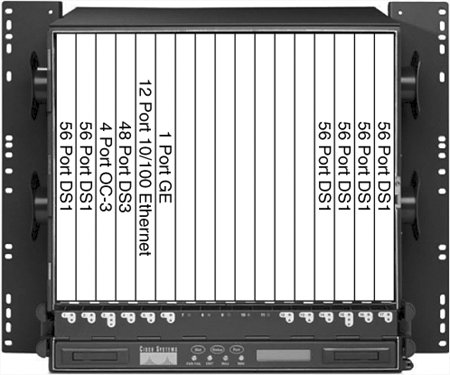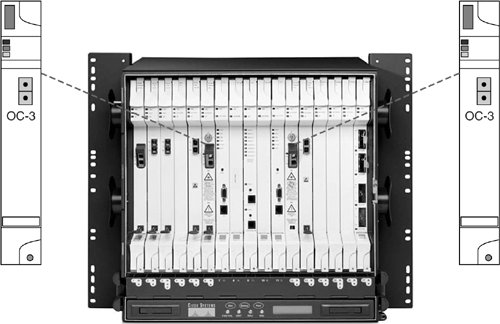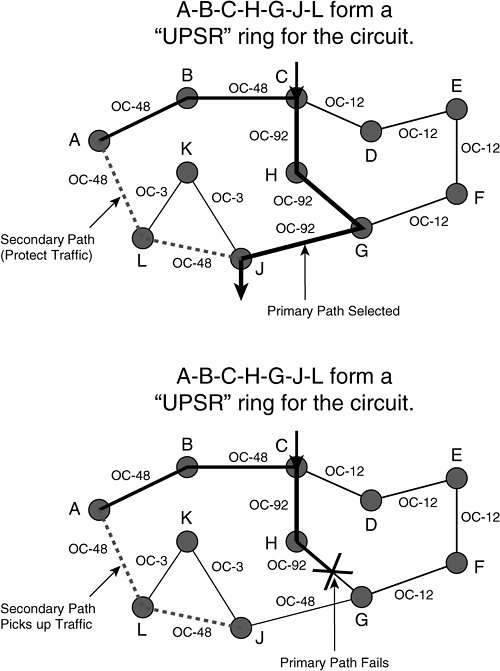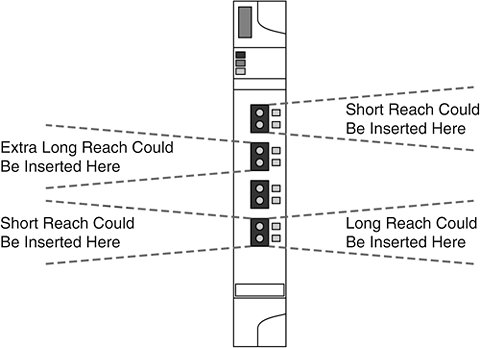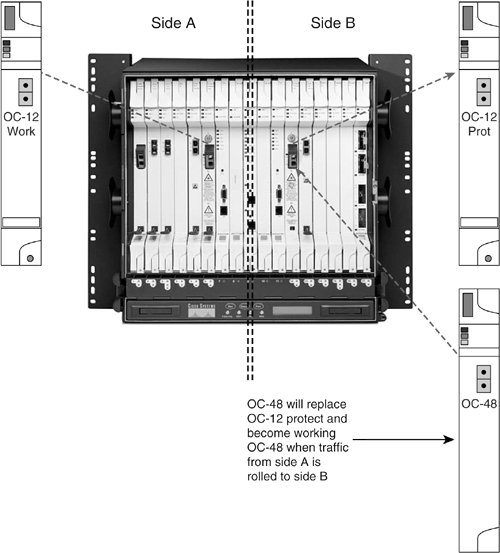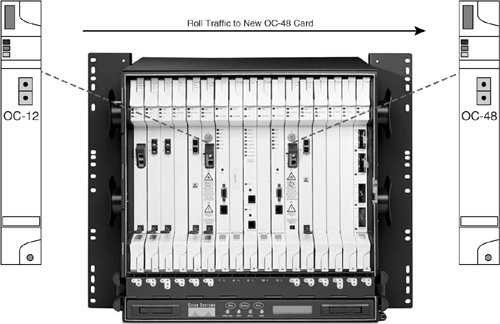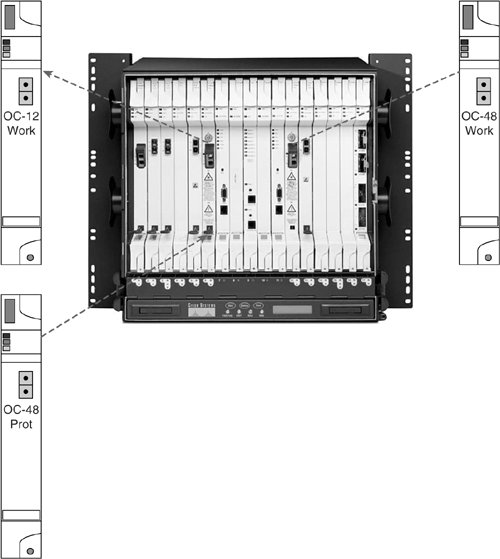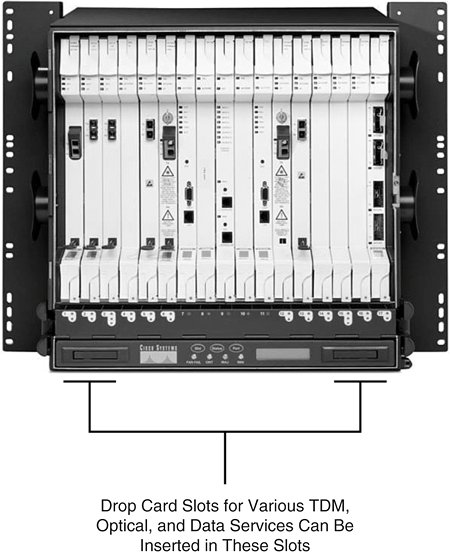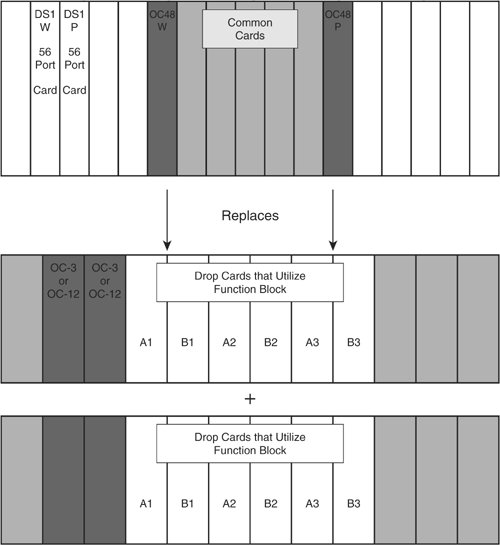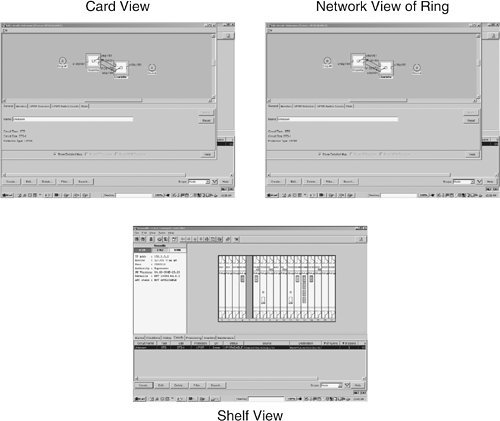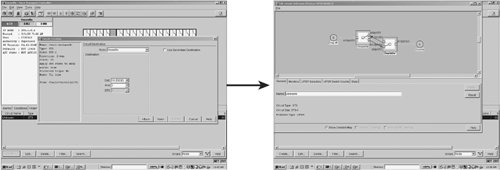Market Drivers
| The mass proliferation of MSPPs is driven by the following three market drivers:
Increased Demand for Bandwidth by LANsAn interesting phenomenon with regard to the proliferation of MSPPs is that, unlike PCs, which experience next-generation technology transformations thanks to increased processing speeds of their components (such as the microprocessor), MSPPs largely have emerged without increasing the optical data-transport ring speeds. Before MSPPs emerged, optical platforms had already achieved speeds of OC-3, OC-12, OC-48, and OC-192. MSPPs did not increase these transport ring speeds, which would have been analogous to an increase in speed of the computer processor. So what led to the explosive growth in demand for MSPPs? The answer is the assimilation of numerous services within the same shelf, along with easy management of these services. Legacy optical systems were limited to only a few different types of service drops, with a limited capacity for mixing these service types. MSPPs, on the other hand, integrate numerous optical and electrical interface cards that carry voice and data services within the same shelf. The port density of these cards is much greater than that of legacy platforms, so they consume much less rack space than legacy systems (see Figure 1-6). Figure 1-6. Example of Service Drops with Much Higher Densities Additionally, MSPPs deliver far more of each service type per MSPP shelf. This allows for a greater variety and quantity of each type of service (ToS). Consequently, the forces behind the movement toward a new generation of Synchronous Optical Network (SONET) equipment in the metropolitan-area network (MAN) or wide-area network (WAN) include easy integration, substantial savings, and the capability to add new services. Along with these primary drivers is a need to improve the scalability and flexibility of SONET while maintaining its fault-tolerant features and resiliency. The focus of first adopters was to integrate add/drop multiplexers (ADMs) and digital cross-connect systems (DCSs) with higher port density and more advanced grooming capabilities than those of the traditional standalone devices. Now the push is toward making SONET more efficient for data delivery. Next-generation data-networking services, such as Ethernet, are also integrated within the MSPPs. Next-generation data-networking services are covered later in this chapter. What drove this demand for increased bandwidth in a smaller footprint? Well, just as more demanding computer applications such as voice and video drove the demand for faster processors, higher-speed LANs drove the need for speedier WANs. The proliferation of the Internet created the demand for a higher-speed LAN to access content. Of course, the speed of accessing content over a LAN is throttled down to the speed at which the WAN can deliver it, as shown in Figure 1-7. With the backbone and core of the WAN as the optical network, the need for more high-speed T1s and T3s grew dramatically to keep up with the demands of the LAN. Figure 1-7. LAN Bottleneck There is no question that the demand for data traffic is growing sharply throughout the public network. A wide variety of services continue to drive the increasing need for bandwidth. Data private lines, ATM, digital subscriber line (DSL), videoconferencing, streaming video, transparent LAN service (TLS), IP/Multiprotocol Label Switching virtual private networks (IP/MPLS VPNs), and other applications are all increasing in use. In addition, transport over delivery services is as different as DS1, DS3, STS-1, OC-3, OC-12, OC-48, 10-/100-Mbps Ethernet, and GigE. Ubiquitous Internet and intranet applications, coupled with the significant rescaling of the interexchange network that has taken place in recent years, further spurs the demand for data services both in MANs and across WANs. Caught between the increased long-haul capacity and the growing access demand from customers, MANs have now become the bottleneck in the overall network. Despite the growing deployment of optical fiber in cities, MAN expansion has not kept up with the increased demand for data transport and value-added IP services that continue to drive bandwidth consumption higher. MAN networks not only need to add capacity, but they also need to be flexible enough to offer cost-effective aggregation of a variety of services at multiple layers, such as TDM packet and wavelength services, to supply the services needed by customers. Along with the emergence of demand for Internet content and the transmission of large documents, such as video clips and photographs, came a cascading effect of demand for larger WAN connections. The surge for increased WAN speeds meant that offices and businesses were looking at speeds of DS3 and even OC-3, OC-12, and OC-48 to connect to their service providers. Additionally, business customers who ordered dedicated rings from their service providers to connect multiple buildings within a metropolitan area desired various service drops to meet the demands of various types of LAN equipment. Thus, a mixture of DS3, DS1, and Ethernet services are all desired in the various locations, as shown in Figure 1-8. Figure 1-8. Customer Application Using Diverse Service Drops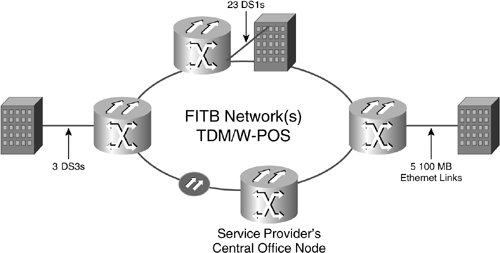 One of the interesting aspects of increasing the available speed on the WAN to support higher LAN speeds is that this increase in speed drove the development of new applications, such as voice and video over data. This, in turn, created an even greater demand for WAN speeds to support these LAN applications. This ripple, or domino, effect of technology is very often seen in computing: An enhancement in the computer video card might enable software writers to write more sophisticated new applications. As the limits of computing technology are pushed, PC developers must again enhance the computer. Rapid Delivery of Next-Generation Data and High-Bandwidth ServicesNext-generation MSPP platforms accelerate service-provider return on investment (ROI) of services such as Ethernet in several ways. First, the startup cost is low because the service provider can install the platform using only the currently required capacity. Then, as demand increases, such as for an OC-48, the node can be scaled to OC-192 and finally to OC-192 DWDM channels. In addition, aggregation of all types of services into each wavelength maximizes bandwidth efficiency and reduces incremental service costs. Efficient DWDM utilization saves 70 to 80 percent of bandwidth, which increases as the network scales. Fewer wavelengths have to be activated, and, as the network expands, carriers do not have to move from the C-band into the more costly L-band to add metro color wavelengths. Overall, service providers can realize a significant ROI in a brief amount of time (such as a single quarter) instead of in 1 to 2 years, as they did previously. With a single platform to deploy instead of many platforms, service providers also limit their operating costs. A one-card interface designed into a multiservice platform saves space so that a single bay can more often handle all the broadband multiplexing and demultiplexing that a network node requires. In fact, when thousands of network interfaces are involved, as in a central office, the savings in vertical rack space from using multiservice platforms can be measured in miles. Additional savings come from an eightfold reduction in power consumption with next-generation multiservice systems. With only one type of platform in use, fewer spare interface cards must be held in inventory. In addition, less training is involved for installation and maintenance. A single network OSS can be used to configure and manage all services, thus minimizing the difficulties involved in administering a network with multiple platforms with multiple bit rates, topologies, and operating systems. A more advanced end-to-end service-provisioning design has been developed for provisioning and restoration across Layers 1 to 3 of the network through the introduction of the Unified Control Plane. All these features work to simplify the network infrastructure, helping to save operating costs and increase profitability. Ethernet ServicesEthernet and other data services actually cause service providers to rethink how they design and architect their local transport networks. These networks were originally designed to carry circuit-switched voice traffic. However, with the emergence of data services, such as Ethernet over the MAN, these networks can be inefficient when it comes to data. Because customers demand a variety of different Ethernet services carriers are finding that a "one size fits all" architecture doesn't work. As these carriers adopt Ethernet technologies that are still new to the OSS, such as to personnel and carriers, they face a delicate balancing act. Should they wait until standards and network-management interfaces are mature and tested before they adopt key enhancements? Or do the benefits outweigh the cost penalties of using a nonstandard solution? The answers tend to be different across carriers and enhancements. For example, Regional Bell Operating Companies (RBOC) are deploying different Ethernet offerings that drive the specifications of the infrastructure that they're using to support them. The great news for these carriers is that MSPP can support all the three major offerings. Traditional Ethernet Service OfferingsTraditional Ethernet services fall into three basic types (see Figure 1-9):
Figure 1-9. Various Ethernet Deployment Models Ethernet Private Line (EPL) services are equivalent to traditional dedicated bandwidth leased-line services offered by service providers. EPL service is a dedicated point-to-point connection from one customer-specified location to another, with guaranteed bandwidth and payload transparency end to end. Ethernet Wire Service (EWS) is a point-to-point connection between a pair of sites. It usually is provided over a shared switched infrastructure within the service provider network, can be shared with one or more other customers, and is offered with various choices of committed bandwidth levels up to the wire speed. To help ensure privacy, the service provider separates each customer's traffic by applying virtual LAN (VLAN) tags. This service is also a great alternative for customers who do not want to pay the expensive cost of a dedicated private line. Ethernet multipoint services are sometimes TLSs because their support typically requires the carrier to create a metro-wide Ethernet network, similar to the corporate LANs that have become a staple of the modern working world. TLSs provide Ethernet connectivity among geographically separated customer locations and use virtual local-area networks (VLANs) to span and connect those locations. Typically, enterprises deploy TLS within a metro area to interconnect multiple enterprise locations. However, TLS also can be extended to locations worldwide. Used this way, TLS tunnels wide-area traffic through VLANs so that the enterprise customer does not need to own and maintain customer premises equipment (CPE) with wide-area interfaces. Customers are unchained from the burden of managing or even being aware of anything with regard to the WAN connection that links their separate LANs. TLS is significantly less expensive and easier to deploy over an Ethernet infrastructure than on a Frame Relay or ATM infrastructure. These lower costs are derived primarily from lower equipment costs. Deploying TLS on Ethernet also provides the increased flexibility carriers obtain in provisioning additional bandwidth, with varying quality of service (QoS) capabilities and service-level agreements (SLAs). With TLS being a low-cost service, the carriers can use it to encourage customers to use a bundled service arrangement. This increases margins and strengthens the customer bonds. Typical value-added services include an Ethernet interface to the Internet, SAN over SONET, and data-center connectivity. To support a shared multipoint offering, carriers traditionally had to install Ethernet switches around a metro fiber ring. These carriers have implemented shared multipoint services directly over fiber, which means that those services do not include SONET restoration capability; this effectively limits them to noncritical traffic. However, carriers that use the metro Ethernet network over MSPP take advantage of SONET's restoration capabilities: redundant fiber paths and 50-ms switching. One leading vendor's multilayer ethernet cards(that is, the card integrates Open Systems Interconnection [OSI] Model Layer 1, Layer 2, and Layer 3 functionality into cards) enables customers to experience actual LAN speed across the metro ring by simply provisioning this card in the MSPP chassis. It offers the added benefits of SONET diversity and rapid restoration technology. This application targets customers who want to interconnect multiple locations, offering a less complicated alternative to the mesh network that they would otherwise need. Unlike with traditional private lines, data can travel across the metro network as fast as it does on a company's internal LAN. Customers connect their own Ethernet equipment to the metro network. All they need is a router interface, which is analogous to Frame Relay architecture. Resilient Packet RingSome carriers refer to this transparent LAN service as resilient packet ring (RPR) architecture for restoration. Unlike SONET architecture, in which half of all available bandwidth typically sits idle, RPR uses the backup, or protection, facilities to carry traffic even under normal conditions. If a failure occurs, traffic is rerouted on a priority basis, as shown in Figure 1-10. Figure 1-10. RPR Using Both Rings Under Normal Conditions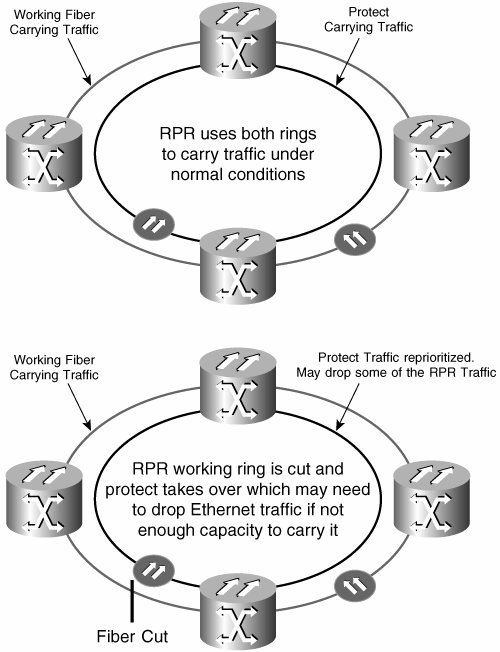 This is attractive to customers who have SONET with extra bandwidth because they can now dedicate part of that bandwidth to the LAN. DWDM Wavelength ServicesFor customers who want Ethernet connectivity at speeds of 1 Gbps or higher, carriers most likely will use a delivery platform based on DWDM in the future. Currently, however, that market is limited to the very largest corporate customers. An enterprise customer's investment in a DWDM network can't be justified merely by Ethernet alone. Today 90 percent of all DWDM sales are for SAN service types of protocol. The price of Ethernet over SONET is three times cheaper than a DWDM-based solution. Over time, however, DWDM-based solutions are likely to become more popular as enterprise customer bandwidth needs increase and as vendors drive equipment costs down. Many vendors are making Ethernet cheaper with course wavelength-division multiplexing (CWDM). DWDM-based offerings can be point-to-point or multipoint. To date, these have been dedicated services, with an entire wavelength used by just a single customer. But some carriers reportedly are experimenting with a shared offering. Figure 1-11 shows one type of DWDM implementation: a variation of a SONET platform called Multi Service Transport Platform (MSTP). In an MSTP application, the transponders and muxponders are integrated into the MSPP shelf itself. Figure 1-11. An MSPP DWDM Application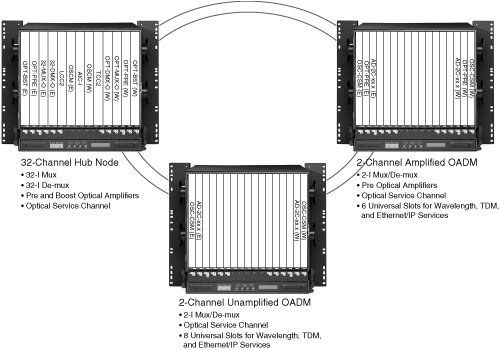 In the other implementation of DWDM, the muxponders are located in a separate device and merely have a specific ITU-T optics wavelength card placed in the MSPP shelf to convert the wavelength of light. These optics wavelengths are then multiplexed into a separate device, sometimes referred to as a filter, and then carried over the fiber to a demultiplexor. There the light signals are redistributed into the corresponding optical cards that read the specific various wavelengths. DWDM over MSPP brings enhanced photonic capabilities directly into the service platform, extends geographical coverage, ensures flexible topology support, and delivers on the requirements of today's multiservice environment. Integrating DWDM into MSPPs, such as the Cisco ONS 15454, provides operational savings and allows the platform to be tailored for MSPP architectures, pure DWDM architectures, or a mixed application set. With the DWDM over MSPP strategy, customers can use a single solution to meet metro transport requirements, ranging from a campus environment to long-haul applications, with significantly more flexibility in the DWDM layer than traditional long-haul solutions. The MSTP strategy consists of three phases: integrated DWDM, flexible photonics, and dynamic services. This MSTP technology allows for any or all wavelengths to be provisioned at any or all the MSTP nodes at any time. DWDM provides unprecedented density in a shelf that has a footprint of one quarter of a 19-inch bay. These wavelength services can be handed to customers and terminated on their customer premises equipment. Figure 1-12 shows a DWDM fiber with several wavelengths carrying various traffic types. Figure 1-12. DWDM Fiber with Several Wavelengths Carrying Various Traffic Types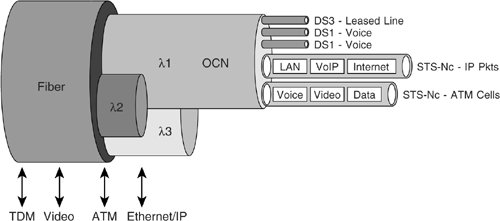 SAN ServicesA number of applications are driving the need for MSPPs to deliver storage-area networking. These include applications for disaster recovery, data backup, SAN extension, and LAN extension. These applications are achieved with services that are delivered over SONET. Storage represents the largest component of enterprise IT spending today, and it is expected to remain so for the foreseeable future. Resident on enterprise storage media is a business's most valuable asset in today's environment of electronic business and commerce information. The complexity of storing and managing this information, which is the lifeblood of corporations in almost every vertical segment of the world economy, has brought about significant growth in the area of SANs. Alongside the growth of SAN implementations is the desire to consolidate and protect the information within a SAN for the purposes of business continuance and disaster recovery (BC/DR) by transporting storage protocols between primary and backup data centers. Enterprises and service providers alike have found that SONET is one of the technologies that best facilitates the connectivity of multiple sites within the MAN and the WAN. MSPP vendors have recognized the need to transport storage protocols over SONET/Synchronous Digital Hierarchy (SDH) networks and have developed the technology and plug-in cards for MSPP. This enables customers to transparently transport FC, FICON, and ESCON. FC technology has become the protocol of choice for the SAN environment. It has also become common as a service interface in metro DWDM networks, and it is considered one of the primary drivers in the DWDM market segment. However, the lack of dark fiber available for lease in the access portion of the network has left SAN managers searching for an affordable and realizable solution to their storage transport needs. Thus, service providers have an opportunity to create revenue streams to efficiently connect to and transport the user's data traffic through FC handoffs. Service providers must deploy metro transport equipment that will enable them to deliver these services cost-effectively and with the reliability their SLAs requirehence the need for MSPPs. Industry experts expect this growth to mirror the growth in Ethernet-based services and recommend following a similar path to adoption. Voice and Video ApplicationsAlthough voice and video are not optical platform data services (instead, these applications ride upon the underlying protocol, such as Ethernet), it is important to cover them here because, in many ways, they are responsible for driving the demand of the underlying metro service, such as Ethernet over SONET. A communications network forms the backbone of any successful organization. These networks serve as a transport for a multitude of applications, including delay-sensitive voice and bandwidth-intensive video. These business applications stretch network capabilities and resources, but also complement, add value to, and enhance every business process. Networks must therefore provide scaleable, secure, predictable, measurable, and sometimes guaranteed services to these applications. Achieving the required QoS by managing the delay, delay variation (jitter), bandwidth, and packet-loss parameters on a network, while maintaining manageability, simplicity, and scalability, is the recipe for maintaining an infrastructure that truly serves the business environment from end to end. One of the benefits that MSPP provides is a very reliable MAN infrastructure upon which to deploy IP telephony and IP video, as shown in Figure 1-13. The 50 ms switch time of SONET provides reliability, and the high data speeds allow thousands of calls to be carried across the MSPP network. Customers and service providers can rapidly deploy these services. Thus, customers who are deploying their own private networks within the metropolitan area using MSPP can quickly turn up service and begin realizing the cost savings of IP-based telephony (IPT) and IP-based video. Likewise, service providers can deploy these services and generate new revenue streams. Figure 1-13. MSPP Infrastructure Used to Deploy Voice over IP (VoIP)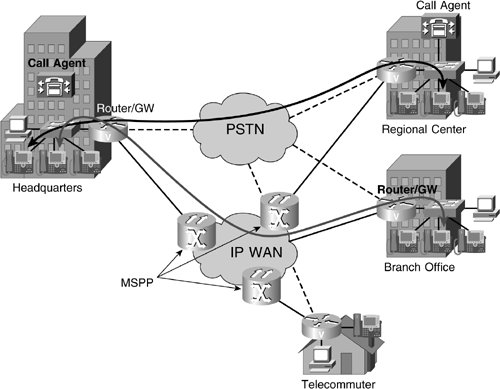 Some cards that can be used within MSPPs use Layer 2 (switching) and Layer 3 (routing) with built-in technology. Cisco calls this card the ML card (for "multiLayer"). This simply suggests that the card contains Layer 1, Layer 2, and Layer 3 features and functionality. Thus, MSPP is an enabling underlying infrastructure for these emerging, high-demand services. Layer 2 functionality handles the switching, thereby creating a truly switched network between the nodes of the optical ring. The Layer 3 service that this ML card provides prioritizes voice and video traffic over data traffic, known as QoS, as shown in Figure 1-14. (This MSPP infrastructure was referred to earlier as RPR.) This virtual LAN feature enables voice and video to flow seamlessly across the MAN. It is called virtual because traditionally the "locality" of LANs has been the premises or campus. Now local is the optical ring, which could be 50 or more miles long, not just what is physically "local" in the traditional use of the word. Figure 1-14. MSPP Multilayer Card Handles Layer 2 Switching and Layer 3 QoS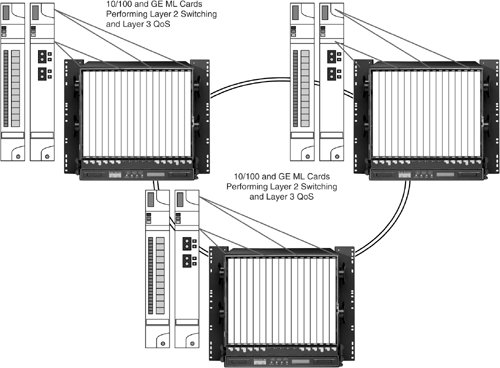 It is important to point out that point-to-point Ethernet over SONET, or Ethernet Private Line, is another means of enabling voice and video, even without RPR. Today's LANs almost always consist of Ethernet as the LAN technology. Thus, when a customer receives an Ethernet handoff from the MSPP, the MSPP is easily integrated right into the LAN infrastructure. The customer or service provider can connect multiple sites with Ethernet Private Lines and then use this underlying infrastructure to transport the higher-layer voice or video. TCOReducing capital and operational expenditures is critically important to the long-term survivability of service providers and enterprise customers. Delivering new services over existing infrastructure enables the service provider to improve top-line revenue numbers and enterprise customers to support additional business capabilities without forklift upgrades. Thus, next-generation platforms must not only deliver advanced multiservice capabilities, but also help reduce the overall costs of operating a network. Legacy Optical PlatformsTo better understand the benefits of next-generation optical MSPP, you should review legacy optical networking architectures. In the next section, you will learn about three different legacy platforms: a legacy OC-3 platform, a legacy OC-12 platform, and a legacy OC-48 platform. Then you will compare them to today's MSPP technology, which delivers the same services. Although numerous vendors provided these legacy platforms, the focus remains on architecture that reflected the leading vendors' legacy optical platforms, to compare MSPP with the best legacy equipment. OC-12 and Below-High-Speed OpticsThe legacy optical platform shown in Figure 1-15 uses OC-3 or OC-12 optical cards for the high-speed cards. The footprint of this platform allows the customer to place six of these in a bay. Not much flexibility exists regarding what services can be delivered or dropped from this OC-3 or OC-12 configured platform. Figure 1-15. OC-12 or Below Platform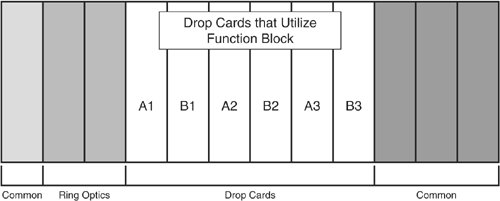 The cross-connecting is done within the high-speed optical cards, OC-3 or OC-12. The system controller, timing, communication, and alarming (user panel) cards reside in the section of the shelf labeled "Common0." The DS1s, DS3s, and other services specific to the vendor are delivered in the section of the shelf labeled "Drop Cards." Different groupings in the shelf are shown as A, B, and C. Each group must consist of either 28 DS1s, 1 DS3, or 1 STS1. Unfortunately, you cannot mix different service cards within the same group: Even if a slot was available in a given group, such as group A, group B, or group C, you could use that slot for only the same service type, such as DS1 or DS3. This means that slots might have to go unused if the service type is not required in any given group. If you are using OC-12 cards on the high-speed slots of this shelf, it could drop out an OC-3. However, this shelf is not upgradeable in service from an OC-3 to an OC-12, and it could never be upgraded to an OC-48 or OC-192. On the other hand, MSPP allows such upgrades simply by taking a 50 ms SONET switch hit. High-bit digital subscriber line (HDSL) is also an option for certain vendors' products in the "Drop Card" section. This shelf can drop out up to 84 DS1s, but in so doing it leaves no room for DS3 or other service drops. This shelf also can drop up to three DS3s per shelf, but, again, nothing else can be dropped. Notice that next-generation service drops, such as Ethernet and SAN protocols (FC, FICON, and ESCON) are available from this platform. There also is no transmux functionality, which allows DS1s to be multiplexed and carried in a DS3 payload through the ring, demultiplexed on the other end, and handed back off as DS1s. Finally, no DWDM functionality exists on this platform. Given the shelf drops, Table 1-1 shows how many services can be dropped from a shelf using this platform.
OC-12 High-Speed Optics OnlyThe legacy platform shown in Figure 1-16 uses OC-12 optical cards only for the high-speed optics. The footprint of this platform allows the customer to place four of these in a bay. Not much flexibility exists for which services can be delivered or dropped from the OC-12 ring. Figure 1-16. Legacy OC-12-Only Platform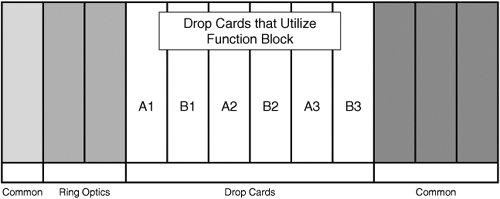 For example, in the OC-3 or OC-12 platforms, you can drop DS1s. This OC-12 can drop only DS3s or EC1s, but not services more granular than a DS3, such as a DS1. You can drop up to four DS3s or EC1s per shelf, and you can mix them as well. OC-1s and OC-3s can also be dropped. Cross-connecting is done in the high-speed optical cards, OC-3 or OC-12. The system controller, timing, communication, and alarming (user panel) cards reside in the section of the shelf labeled "Common." The DS3s or EC1s, and other services specific to the vendor are delivered in the section of the shelf labeled "Drop Cards." Again, as with the OC-3/OC-12 shelf, this shelf is not upgradeable to any other optical ring speed other than OC-12. MSPP allows such upgrades simply by taking a 50 ms SONET switch hit. Just as in the previous case, notice that advanced services, such as Ethernet and SAN protocols (FC, FICON, or ESCON) are available from this platform. No transmux functionality or DWDM functionality on this platform is integrated into the SONET platform. Given the shelf drops, Table 1-2 shows how many services can be dropped from a shelf using a typical legacy OC-12 optical platform.
OC-48 High-Speed Optics OnlyThe legacy platform as shown in Figure 1-17 uses OC-48 optical cards only for the high-speed optics. The footprint of this platform allows the customer to place two of these in a bay. Not much flexibility exists regarding which services can be delivered or dropped from the OC-48 ring. Figure 1-17. Legacy OC-48-Only Platform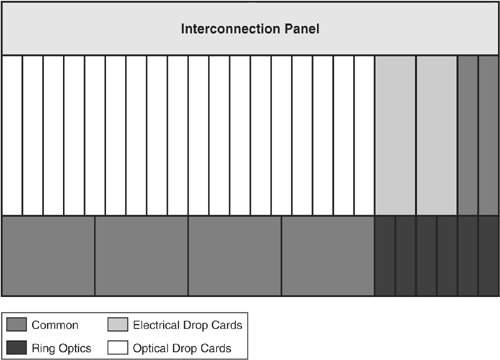 For example, in the OC-12 platform, you cannot drop DS1s. This OC-48 can drop only DS3s or EC1s, but not services which are more granular than a DS3, such as a DS1. You can drop up to 48 DS3s or EC1s per shelf, and you also can mix them. Again, just as with the OC-12-only shelf, OC-1s and OC-3s can be dropped. OC-12s can be dropped from the OC-48-only platform, but keep in mind that these cards weigh more than 25 pounds each. The cross-connections are performed on the high-speed optical cards, OC-3 or OC-12. The system controller, timing, communication, and alarming (user panel) cards reside in the section of the shelf labeled "Common." The DS3s or EC1s or OC-12, or other services specific to the vendor are delivered in the section of the shelf labeled "Drop Cards." Again, as with the OC-3/OC-12 shelf, this shelf is not upgradeable to any other optical ring speed than OC-48. Just as in the previous cases, notice that advanced services, such as Ethernet and SAN protocols (FC, FICON, or ESCON) are available from this platform. There also is no transmux functionality or DWDM functionality on this platform that is integrated into the SONET platform. Given the shelf drops, Table 1-3 shows how many services can be dropped from a shelf using a typical legacy OC-48 optical platform.
MSPPTo compare the OC-3/OC-12, OC-12-only, and OC-48-only legacy platforms shown in the last section with the same implementation of OC-3, OC-12, and OC-48 on MSPPs, take a look at Figures 1-18, 1-19, and 1-20. Figure 1-18. MSPP Configured for OC-3 Figure 1-19. MSPP Configured for OC-12 High-Speed Optics Figure 1-20. MSPP Configured for OC-48 High-Speed Optics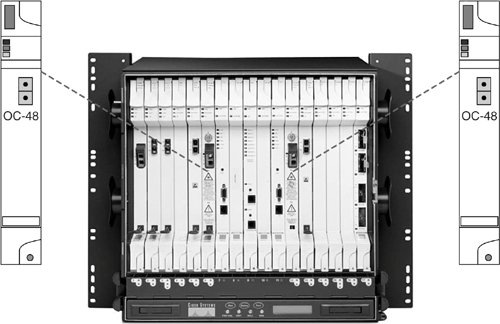 Figure 1-18 shows an MSPP configured for OC-3 high-speed optics. Figure 1-19 shows an MSPP configured for OC-12 high-speed optics. Figure 1-20 shows an MSPP configured for OC-48 high-speed optics. MSPP offers so many advantages that it is difficult to know where to begin. Not only do MSPPs provide flexibility within the shelf, but they also allow for very flexible topologies, as shown in Figure 1-21. Figure 1-21. Various Topologies Available for MSPPs Integrated within a Network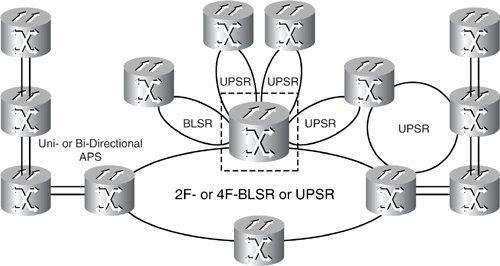 With MSPPs, it is easy to configure the topology of the MSPP network by simply pointing and clicking on the desired topology choice within the graphical user interface (GUI). Choices include 2F or 4F bidirectional line switched ring (BLSR), unidirectional path switched ring (UPSR), and unidirectional or bidirectional APS. An MSPP must support a wide variety of network topologies. In SONET, the capability to support UPSR as stated by the Telcordia GR-1400, 2-Fiber BLSR and 4-Fiber BLSR as stated by the Telcordia GR-1230, and 1+1 APS is essential. Figure 1-22 shows the flexibility of Path Protected Mesh Networks (PPMN) and a path-protection scheme. A path-protection scheme based on meshing is similar to a routing environment: Not only does it offer ease of management and provisioning, but it also can provide significant cost savings. Because of its strict adherence to SONET standards, a PPMN logical ring is similar to the Telecordia-specified standard for UPSR. These cost savings are realized when network span needs to be scaled to a higher bandwidth. Without PPMN functionality, a complete UPSR ring must be upgraded with new higher-rate optics, even if only a fraction of the ring needs the additional bandwidth. Figure 1-22. Path-Protected Meshed Network Topology and Protection Scheme With PPMN, only spans that require the additional bandwidth are upgraded, thus reducing the overall cost to support additional higher-bandwidth services. Unfortunately, RBOCs that are encumbered with legacy OSS cannot take advantage of the benefits of PPMN. Therefore, this is seen predominately in the Enterprise and CLEC networks. High-Speed Optical CardsWhen using the high-speed optics of MSPPs, notice that the shelf is the same, regardless of which set of high-speed slots cards you are using (such as OC-3, OC-12, OC-48, or even OC-192 optics). Note The MSPP used throughout this book is a leading vendor's platform; sections are labeled as "Common," "Main"- High Speed Optics, and "Drop Cards." Instead of building cross-connect functionality into the high-speed slot optical cards, as in numerous legacy platforms, this functionality resides within dedicated cross-connect cards. The division of tasks thus is reflected in the architecture, making it easy to upgrade optics. High-speed optics use a dedicated transmit/receive port. They also weigh nothing close to what legacy cards did because of the exponential improvement in electronics and optical technology. Next-generation MSPP optics cards use Small Form Factor Pluggables (SFP), similar to the way Gig E uses Gigabit Interface Connectors (GBICs). The user thus requires only a multirate card for sparing because that card can use the SFP technology. Again, this is similar to the GBICs, which, though they all provide Ethernet protocol service drops, have varying span budgets and loss specifications (such as short reach, long reach, and extra long reach), as shown in Figure 1-23. Figure 1-23. Gigabit Ethernet Using Varying GBICs for Different SPAN Budget Requirements MSPP offers added features, including in-service optical line rate upgrades (or downgrades, if necessary). These are quite simple to perform. The following example illustrates performing an upgrade from OC-12 to OC-48:
The upgrade is complete. The traffic can stay on the OC-48 card as is or can be rolled back onto the second OC-48 card that was installed. This is up to the user and procedures used. As mentioned, DWDM capabilities are also available on the high-speed optical cards. Various wavelengths, as defined by the ITU, can be multiplexed over the fiber, thus improving the overall bandwidth of the fiber by orders of magnitude. For example, you could multiplex up to 32 wavelengths of OC-48 over a single fiber, providing an incredible OC-1536 bandwidth, as shown in Figure 1-27. Figure 1-28 shows DWDM delivered off MSPP shelves. Figure 1-27. Eighteen DWDM Wavelengths Multiplexed over a Single Fiber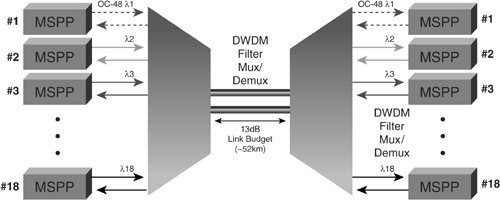 Figure 1-28. DWDM off MSPP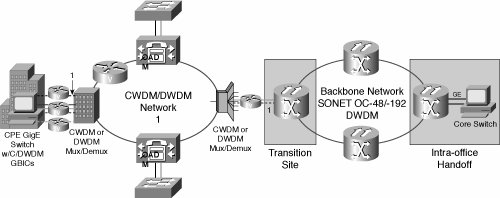 Table 1-4 lists the DWDM wavelengths as defined by the ITU for OC-48 and OC-192.
The value of MSPPs is found in the utilization, density, and flexibility of drops or service cards. Both legacy and next-generation MSPPs require high-speed optical cards and use them in a similar manner; the exceptions (as previously shown) include upgradeability, flexibility, and ring optic shelf space requirements. However, as you will see throughout the rest of this chapter, the density of these services has increased in MSPPs in many cases. Looking at Figure 1-29, you can see that a number of slots available for drop cards can deliver various services. This varies depending on the vendor. Figure 1-29. Drop Cards off MSPP Again, the common cards and high-speed slot optical cards are in the central seven slots of the shelf. This leaves the rest of the shelf available for drop cards; these can be electrical, optical, or data services cards, or any combination of these. Electrical Service CardsElectrical cards are sometimes referred to as TDM-based cards. Depending on the vendor, each card is commonly referred to as low density or high density. An OC-48, for example, can carry 48 DS3s, and an OC-192 can carry 192 DS3s on the ring. If low-density cards are used, as shown in Figure 1-30, you could fill the entire left side of the shelf and drop out 48 DS3s if each working card has 12 ports. Figure 1-31 shows a high-density application in which there are 48 ports on each working and protection card. Figure 1-30. MSPP Shelf Filled with Electrical Cards Figure 1-31. MSPP Filled with 48 DS3s on Left Side of Shelf This brings up another advantage of MSPP over many legacy platforms: protection schemes. MSPPs allow what is referred to as either 1:1 (1 by 1) or 1:n (1 by n) protection for electrical DS1, DS3, and EC-1 cards, as Figure 1-32 shows. In this example, DS3 cards have 12 ports each, and DS1 cards have 14 ports each. Figure 1-32. 1:1 and 1:n Protection Schemes for Low-Density Cards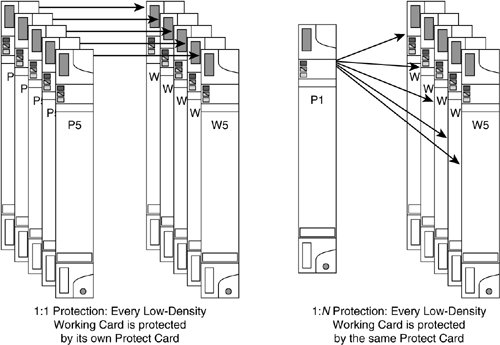 1:1 protection means that every card that will carry live traffic must have another card that will protect it if it fails. 1:n protection means that a protection card can protect two or more cards ("n" cards) where n is 1 to 5. If high-density cards are used in this leading vendor's MSPP, as shown in Figure 1-33, the user can drop up to 48 DS3s out of each card. This requires only two working cards and one protection card, totaling three slots, to drop out 96 DS3s per side. With five service or drop slots per side, this leaves two slots per side available for other service cards, such as optical or data cards. (Keep in mind that DS3 cards have 48 ports each and DS1 cards have 56 ports each.) This also allows all 192 DS3s to be dropped from this shelf, if necessary. Figure 1-33. 1 and 1:n Protection Schemes for High-Density Cards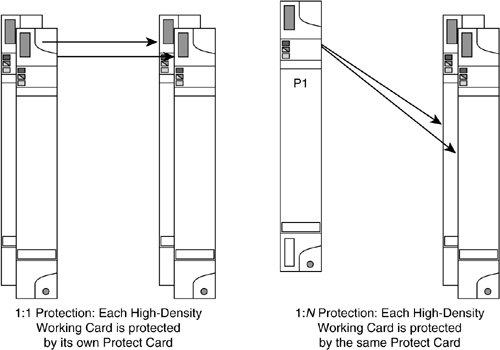 A similar scenario exists for DS1 cards. DS1 cards come in the same two flavors, low density and high density. Low-density cards have about 14 ports per card. High-density cards will have up to 56 DS1 ports per card. Again, this is a quantum leap over legacy equipment. Just one DS1 working card and one DS1 protection card, using just two slots in one MSPP shelf, can replace two entire OC-3/OC-12 legacy shelves, as shown in Figure 1-34. Figure 1-34. Two MSPP High-Density DS1 Cards Replace Two Legacy Platform Shelves Now consider that an MSPP shelf filled with four working DS1 high-density cards (two on each side) and two protection DS1 high-density cards (one on each side) can drop 224 DS1s and leave four slots available (two on each side) for other optical or data service cards. One MSPP shelf can drop out more DS1s than an entire bay of legacy shelves. Optical Service CardsFigure 1-35 shows some typical optical cards and port densities, (densities vary by vendor). OC-3 cards come in various port densities, such as one-port, four-port, and eight-port cards. OC-12 cards come in single-port and four-port cards. OC-48 and OC-192 come in single-port cards. Today there are even multirate cards that offer 12 optical ports that can accept SFPs for OC-3, OC-12, and OC-48 optics, for incredible density and variety in a single slot. Various wavelength SFPs also exist for these optical cards, for various distance requirements based on signal loss over the fiber. This is often referred to as span budget, and it is noted in decibels (dB). Figure 1-35. Typical Optical Cards Used in MSPP 1+1 (1 plus 1) protection is used to protect the optical ports when protection is required. Thus, any given port on a four-port OC-3 card (protection port) will protect another port on a four-port OC-3 card (working port). In the shelf under consideration, there are ten service slots. This means that up to ten optical cards of any sort can be used, as long as the required STSs (1 STS-1 is equivalent to an OC-1) required to be carried on the ring do not exceed the bandwidth of the high-speed optical cards. Thus, if the high-speed optical cards are OC-48, you can mix any type of optical card based on service requirements as desired. However, you cannot carry more than a combined number of 48 STSs on the ring (assuming that a UPSR is used). Also, if every optical card required protection, that would allow six pair of optical cards, with each pair consisting of one working card and one protect card. Again, these can be mixed based on drop requirements. With the recent emergence of the multirate optical card, the distinction between high-speed optics and low-speed optics on a slot-by-slot basis is no longer a factor: Both high-speed and low-speed cards can be used in the same slot. Thus, you can see the enormous leap in density and flexibility of these optical cards, as well as a greatly reduced space requirement. Optics cards can also be mixed with electrical service cards and data service cards, as discussed in the next section. Data Service CardsThe primary data cards in use today are Ethernet cards. They typically come in two basic speed categories, 10/100 Mb and 1 Gb speeds. The gigabit cards can have fixed optics ports and can be open-slotted (for the insertion of GBIC) to allow different optical wavelengths for different distance requirements based on signal loss over the fiber. The 10-/100-Mb cards typically come in 8-port to 12-port densities; the gigabit cards come in single-port to four-port cards. The gigabit cards can also be provisioned at a subrate speed, such as less than 1 Gb. This allows service providers to sell subrate gigabit and metered services, and gives flexibility to their product offerings: If a customer needs more than 100 Mb of bandwidth but less than a gigabit, bandwidth can be provisioned so as to not require full utilization of 21 to 24 STSs, depending on the vendor's equipment (1 STS or OC-1 is approximately 51.84 Mb), to be dedicated per gigabit port. Along with Layer 1 Ethernet over SONET implementations, MSPP has the capability to use Layer 2 and Layer 3 routing features to provide multilayer Ethernet. Multilayer Ethernet cards enable the user to use Layer 2 switching and Layer 3 routing features. One of the most significant is that of QoS, which is used to classify, prioritize, and queue traffic based on traffic type. As mentioned earlier in this chapter, certain traffic, such as voice and video, cannot tolerate latency, so it must be given priority when competing with data traffic for the available bandwidth. These multilayer cards also allow carriers to provide, or customers to privately deploy, a transparent LAN. In addition, this service must allow any number of customer VLANs to be tunneled together so that the metro network is run by the service provider and so that the customer is not limited by number or forced to use specific assigned VLANs. Figure 1-36 illustrates how the metro Ethernet services overlay on the metro optical transport network and the proposed architecture to deliver TLSs. The TLS flow is end to end between the switches. Figure 1-36. Ethernet LAN Services from End to End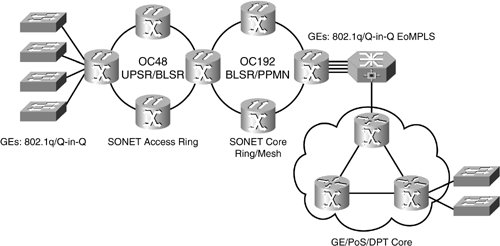 SAN Service CardsAs mentioned earlier, certain cards deliver SAN protocol services. These are some of the key features and functions of the SAN cards:
Some of the advantages of SAN over SONET include these:
Additionally, MSPP SAN features include the following:
OAM&POne of the most important aspects of any piece of equipment is the ongoing costs associated with provisioning or commissioning the equipment, operating it, administering the installed base of that equipment, and maintaining it. Industry pundits refer to this as OAM&P, for operations, administration, maintenance, and provisioning. Some of the OAM&P advantages that MSPPs have over legacy platforms to which we have already alluded are listed here:
GUIGUIs are used with MSPP and allow point-and-click interaction, rapidly improving the speed of provisioning. GUI interfaces have gained acceptance among service providers, allowing technicians to perform OAM&P functions intuitively and with less training. In addition to the GUI, the MSPP should offer traditional command-line interfaces (CLIs) such as the widely accepted Telcordia TL1 interface. A leading MSPP provides network, element, and card views of SONET. This enables the user to point to a node on a map and click on it to bring up the node view. You can then click on a card in the element view and provision card-level settings. This is a time saver because it enables the user to literally turn up a multinode ring in just minutes or hours instead of days. With IP as the communication protocol, you can access the elements from literally anywhere in the world if you have access to the Internet and know the appropriate passwords. End-to-End ProvisioningWith cross-network circuit provisioning, circuits can be provisioned across network elements without needing to provision the circuit on a node-by-node basis. The MSPP can reduce the required time to provision a circuit to less than 1 minute, as shown in Figure 1-37. Different views of the map, shelf, and card enable users to quickly navigate through screens during provisioning, testing, turn-ups, and troubleshooting. Figure 1-37. Map View and Shelf View of MSPPs WizardsProcedure wizards guide users step by step through complicated functions (see Figure 1-38). By employing wizards, features such as span upgrade, software installations, and circuit provisioning are available. These MSPP wizards dramatically reduce the complexity of many OAM&P tasks. Figure 1-38. An End-to-End Provisioning Sequence of Screens AlarmsAlarming screens are also advanced as compared to legacy platforms. Alarm logs can be archived more easily because LAN equipment using the IP protocol is connected to the MSPP. In addition, alarms are displayed automatically as they arise on the craft interface and show when they have been acknowledged and cleared, with different colors for easy recognition. In legacy platform craft interfaces, alarms had to be manually retrieved to be seen: If an alarm occurred, it sometimes took minutes or hours to be identified because the alarms were not automatically displayed. Additionally, there was no color indication to help facilitate the process of identifying which state alarms were in. Alarms could be logged but not viewed as easily when looking for patterns and diagnosing recurring problems. Software DownloadsMSPP has simplified software downloads. In the past, what called for a craft person to be on site is now a simple function of a point-and-select function of the software from any location with TCP/IP access. Thanks to IP management enabled on MSPP, these updates can be scheduled from servers to be done automatically during off-peak usage hours. This takes advantage of server and data-networking technology, reducing the personnel required to perform them and also the time it takes to execute the update. Event LoggingEvent logging has existed in legacy optical platforms; however, the logs had to be manually retrieved. The data in the log could not be color-coded for easy recognition. Imagine looking at event log history that dated back perhaps months without a color code classifying certain event typesit could take hours to find the data you need. With MSPP GUI color codes, the search for data can be accelerated dramatically, enabling you to complete a search in minutes versus what could potentially take hours. Capital Expense ReductionIt goes almost without saying that the capital expenditure (capex) reduction is significant for those who use MSPPs. A ring can be deployed today from 25 to more than 50 percent of the cost of a legacy ring because of the increase of port density per card and the overall shelf density. If there were no operational advantages, the savings in capex alone would be enough to justify the migration to MSPP. Not only have the technology improvements allowed for greater port densities and numerous service drops on each shelf, but MSPP component costs have also greatly been reduced: More MSPP manufacturers are in the market today than when only legacy platforms existed. The rapid deployment of services on MSPP and the reduced cost barrier to entry into the market have increased the number of service providers who offer services off MSPPs. In the past, only a few service providers (perhaps even only one service provider) were in any one market because of either regulatory constraints on competition or cost barriers to entry. The expense of building a large network is enormous. No revenue can be realized until the network is in place, and even when the network is complete, there is no guarantee that the revenue will be adequate to pay for the investment. With deregulation of the telecommunications industry, competitive carriers could lease the incumbent networks. They would thus gain a more cost-effective pseudo-network infrastructure and bring in revenue to offset the costs of gradually building their own networks. Another emerging phenomenon in the electronics industry that blossomed about the time MSPPs began to proliferate is that of outsourcing electronic component manufacturing by MSPP vendors. Electronic component manufacturing suppliers (EMS) have had to become extremely price-conscious to keep from losing business from their key MSPP customers. A brief review of the evolution of the EMS industry will shed a little light on the overall component price-reduction phenomenon. Outsourcing in the electronics industry has evolved dramatically during the past decade. In its earliest and most basic form, the MSPP manufacturers made "manufacture vs. outsource" decisions based largely on opportunities to reduce costs or meet specialized manufacturing needs. The EMS companies took on manufacturing for specific products on a contract-by-contract basis. Through economies of scale across many such contracts, EMSs leveraged operational expertise, lower-cost labor, and buying power (or some combination of these) to lower the costs to the MSPP manufacturer. For instance, an MSPP manufacturer that made a broad range of optics products could achieve greater economics by working with an EMS that specialized in building these components instead of maintaining that capability in-house. Because the EMS built far more optics products than the MSPP manufacturer ever would, the EMS received significant volume discounts from its own supplierssavings that the EMS passed along in part to its customers. Also, because the EMS specialized in manufacturing, it was more efficient in reducing setup and changeover times. Such conventional outsourcing served electronics legacy platform manufacturers well into the mid-1990s, when demand was relatively predictable, competition was less fierce, and products were simpler. Then things began to change. Products grew more complex. As MSPP manufacturers emerged, they found that they had to dramatically boost investments in capital equipment to keep up with new manufacturing requirements, which ate into profits. The pace of innovation increased dramatically, leading to shorter product life cycles and increased pressure to decrease time to market. In response, a number of MSPP manufacturers have used outsourcing to quickly and cost-effectively enter new markets. By teaming with an experienced partner, an MSPP manufacturer can significantly cut the time and cost involved in developing new products. Some MSPP manufacturers found that a move toward more collaborative outsourcing arrangements could improve their planning accuracy and capability to respond more quickly to changing market conditions. By outsourcing manufacturing and some of their "upstream" supply chain activities, MSPP manufacturers could free themselves to focus on their core competencies, tighten planning processes, and be more responsive to customer demand, whether this was a service provider or enterprise customer. Instead of having to ramp up or down the workforce, or start and shut down operations, the MSPP manufacturer could simply adjust the fee structure of the outsourcing agreement. This increased demand for EMS products created an increased competition among electronic component manufacturing suppliers, thus driving down overall component prices (as competition always does) and greatly reduced the production cost of the MSPPs themselves. This increased demand for MSPPs meant that component suppliers to the MSPP manufacturers could ramp up production and thus decrease the per-unit production costs of the componentsanother case of "demand creating demand." Thus, MSPP suppliers, now more numerous, were forced to be more competitive and pass on this cost savings to the service providers themselves. This then reduced the overall capital costs for the service provider. Thus, service providers receive a less expensive MSPP that can deliver more services, which are far more diverse from a reduced footprint. This, of course, means that the end customer of the TDM, optical, and data services has a choice of service providers and can negotiate more fiercely and get more bandwidth for the dollar. Now you can see the supply chain effect from beginning to end: MSPP suppliers receive better component pricing because of the volumes these component manufacturers produce. These savings are passed along to MSPP customers in the form of more competitive pricing. This, in turn, is passed along to the customers who buy the services from the service providers. |
EAN: 2147483647
Pages: 140
